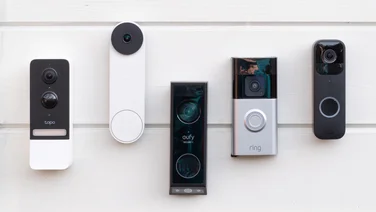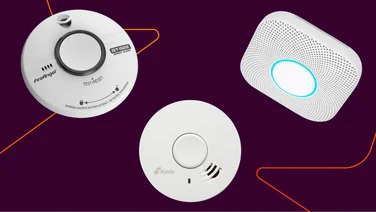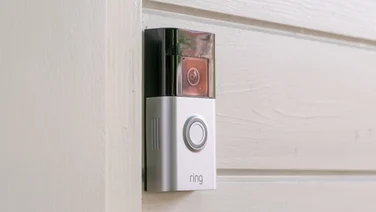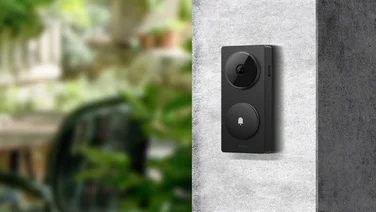To help us provide you with free impartial advice, we may earn a commission if you buy through links on our site. Learn more








- Support for Zigbee, Z-Wave and other devices
- Easy to add new sensors, switches and devices
- Excellent features for scenes and automated routines
- All the sensors, smart outlets and buttons you could need
- Needs better integration across more devices
- Can't operate Hue bulbs without Hue hub
- Limited Alexa voice controls
Perhaps the biggest issue with the smart home is that old devil, fragmentation. With different ecosystems, different wireless standards and different hubs and apps all in play, it’s still easy to end up with a home where you’re using separate apps to control the lighting and the heating, or where you have to employ complex workarounds to create routines that handle more than one set of devices.
It’s a problem that the world’s biggest tech companies all want to solve, with Amazon, Apple and Google each promoting their own smart home systems, apps and devices.
However, Samsung is going further than most with SmartThings. It’s not so much another ecosystem as the ecosystem to rule all ecosystems. It puts your lighting, heating, security and entertainment under the control of just one hub and just one app.
READ NEXT: Our full review of the latest Amazon Echo Plus
Samsung SmartThings review: Installation
As with most Smart home ecosystems, the core of SmartThings is a dedicated hub. This plugs into the mains and connects to your router using either the Ethernet cable provided or Wi-Fi.








Software setup couldn’t be much easier. You install the app on your smartphone or tablet – there are Android and iOS versions – set up your SmartThings account, then add the Hub as a new device. The app scans a QR code on the Hub to register it, then it’s just a question of setting up Wi-Fi connectivity if needed, and specifying the location for any geolocation features. A few minutes later you can start adding devices.
If they’re Samsung devices that process is just as easy, though perhaps not as automatic as you’d hope; while the router will scan for new devices, you need to select the type, brand and model in most cases, even if you’re adding Samsung SmartThings-branded kit.
From there on in, though, it’s just about faultless. With SmartThings products you just add the QR code and within seconds the device is on your network. Other devices we tried connected almost as easily, though in some cases there are extra steps involved.








With Philips Hue bulbs, for example, you can’t connect the bulbs directly to the Hub as you can with, say, an Amazon Echo Plus. Instead, you need to keep your existing Hue bridge connected to your router, remove and reconnect Ethernet to it, then press the button on top to get it paired to the SmartThings Hub. Even then, the SmartThings app needs to install an extra control applet before you can alter the brightness, change the tone or colour or even turn the bulb on and off.
SmartThings is unusual in that it supports both the ZigBee and Z-Wave wireless standards, so it covers a huge range of different smart home products provided they’re supported in the SmartThings app. Both ZigBee and Z-Wave are mesh networks, which means devices act as nodes that pass messages back and forth between the Hub and other devices.
While this makes both standards more effective than Wi-Fi or Bluetooth across long distances – and a lot more power-efficient – it means the mesh breaks down if there are large gaps or interference problems between nodes. This often causes grief when you’re setting up the kit. Impressively, though, these issues never raised their ugly heads when installing SmartThings. Every switch, every sensor and every Innr bulb we connected was discovered and worked first time.
Samsung SmartThings review: Products and Accessories
SmartThings is odd in that Samsung isn’t making bulbs like Philips or thermostats like Hive, but goes further than Amazon, Apple or Google in developing and certifying smart home products. While you can buy the Hive solo, it also comes in various kits with Samsung’s Multipurpose sensor (£24), Power Outlet (£46), Motion Sensor (£25), Water Leak Sensor (£25) and Smart Button (£25).








All are extremely compact and share the same elegant, rounded white design, and one or more is pretty much essential to getting the most out of the SmartThings system.
We’re particularly keen on the Multipurpose sensor, which can trigger alerts or automated routines when a door or window is opened or even when someone knocks, but the Smart Button is also very handy, as you can assign functions for clicking, double-clicking or clicking and holding.








The others do much as you’d expect, but interestingly all the sensors – and the button – contain built-in temperature sensing, too; handy if you want to automate the heating without putting specific thermostats or temperature sensors around the house.
Otherwise, Samsung supports a wide range of Works with SmartThings products, including Netatmo’s Smart Thermostat, Yale Keyless locks, Amazon and Google smart speakers, power outlets, light bulbs, cameras, radiator valves and more.








SmartThings will also pick up Samsung washing machines and even many Samsung TVs and soundbars. My own 2016 Series 6 4K set was detected and could be controlled through the SmartThings app though not, rather annoyingly, turned on. Even with the set in standby, it was listed as disconnected.
The surprising thing is that SmartThings will also work with some products Samsung doesn’t actively claim it will. For instance, while SmartThings only explicitly supports Bose SoundTouch speakers, the app detected and would operate a Sonos Play 1 speaker, to the extent that I could integrate it into automated routines.
Again, there’s a gotcha – I had to set up a playlist first in the Sonos app, as the SmartThings app would only play, pause, skip and adjust the volume. All the same, having music kick in when I enter the dining room is, well, kind of fun.








There’s a sense that Samsung still has work to do here, especially with the momentum behind Amazon’s Echo devices and the Echo Plus’s built-in hub. Yet Samsung’s smart, highly-integrated way of doing things – not to mention ZigBee and Z-Wave compatibility – makes it a great ecosystem to work with, and one that could get even better.
Samsung SmartThings review: App and Controls
Samsung’s App is arguably the best thing about SmartThings. Once you add devices it’s easy to group them into rooms, rename them if you need to and control their basic functions.
While the Philips Hue app arguably does a better job of controlling your lighting, the strength of SmartThings is the way you can integrate that lighting with Samsung’s sensors and other smart home devices. Want to turn the hall lights on for a few minutes and turn the heating up when you come in through the front door? SmartThings can help you do it.
And despite the control limitations of my TV, I was able to create a routine that dimmed the lights, switched TV sources, changed picture profile and adjusted the volume ready for an Xbox gaming session (if only the console itself would turn on and boot Apex Legends, all would be complete).








The SmartThings app has two main ways of programming: Scenes and Automations. Scenes enable you to set up combinations of all your different SmartThings devices, so that lights turn on or off, fade or change colour, music starts playing at a preset volume, the heating turns up or down – that kind of thing.
Automations, meanwhile, enable you to set devices to behave in certain ways in reaction to particular triggers, whether that’s a user’s smartphone entering the smart home boundary, a certain time of day or the activation of a button or a sensor.
These take a little time to program and sometimes a little more to fix when you do something daft, but they’re the key to getting the most out of your smarter home and even improving your energy efficiency, so that lights turn off when rooms aren’t occupied.
Samsung’s app handles both Automations and Scenes really well. Admittedly I’ve had a little more practice configuring smart home tech than most, but I breezed through programming both, mostly because it’s all laid out logically and sequentially and you don’t have to keep skipping between screens to get things up and running.
Samsung SmartThings review: Voice Assistants
One of the only real annoyances about SmartThings is that it assumes you’ll be using Samsung’s little-loved Bixby to control your smart home – or at least that you will if you use a Samsung phone. You can, and it works quite effectively, but if you’d rather keep ignoring Bixby and use Alexa or Google Assistant, then SmartThings will integrate with both.
With Alexa that means going through the usual routine of adding the SmartThings skill then slowly and painfully setting up each individual device in a new group. For some reason it can’t just carry through your existing rooms, though any scenes you’ve setup do transfer.
Once you’ve gone through that particular purgatory, all works roughly as it should, and you can activate a scene or dim the lights with voice alone. Sadly, you can’t activate scenes or automations that affect anything beyond heating and lighting. This makes sense when we’re talking security, but why not our other smart devices?
READ NEXT: Our lowdown of the best smart thermostats money can buy
Samsung SmartThings review: Verdict
SmartThings is nearly the ultimate smart home ecosystem; it does its best to support nearly everything and the app is well-designed, consistent and surprisingly easy to use. The way it integrates Samsung’s own sensors and switches with a wide range of third-party products means you can get stuck into some really interesting and powerful automation – arguably more so than with any other system. It’s also very competitively priced, particularly if you’d rather control your existing music system than add more Echo speakers to the mix.
If anything holds it back, it’s that it still doesn’t allow direct control of some popular smart home products – with Philips Hue bulbs the obvious example – and that, while it beats Amazon’s ecosystem on ease-of-use, features and Z-Wave support, Echo Plus works better across a wider range of products, without so many limitations or workarounds.
SmartThings has potential and could become your one smart home system that manages the rest. It’s close, but it’s not there quite yet.

![SmartThings Hub 3rd Generation [GP-U999SJVLGDA] Smart Home Automation Hub Home Monitoring Smart Devices - Alexa Google Home Compatible - Zigbee, Z-Wave, Cloud to Cloud Protocols – White](https://m.media-amazon.com/images/I/21hChu0ounL._SL160_.jpg)






